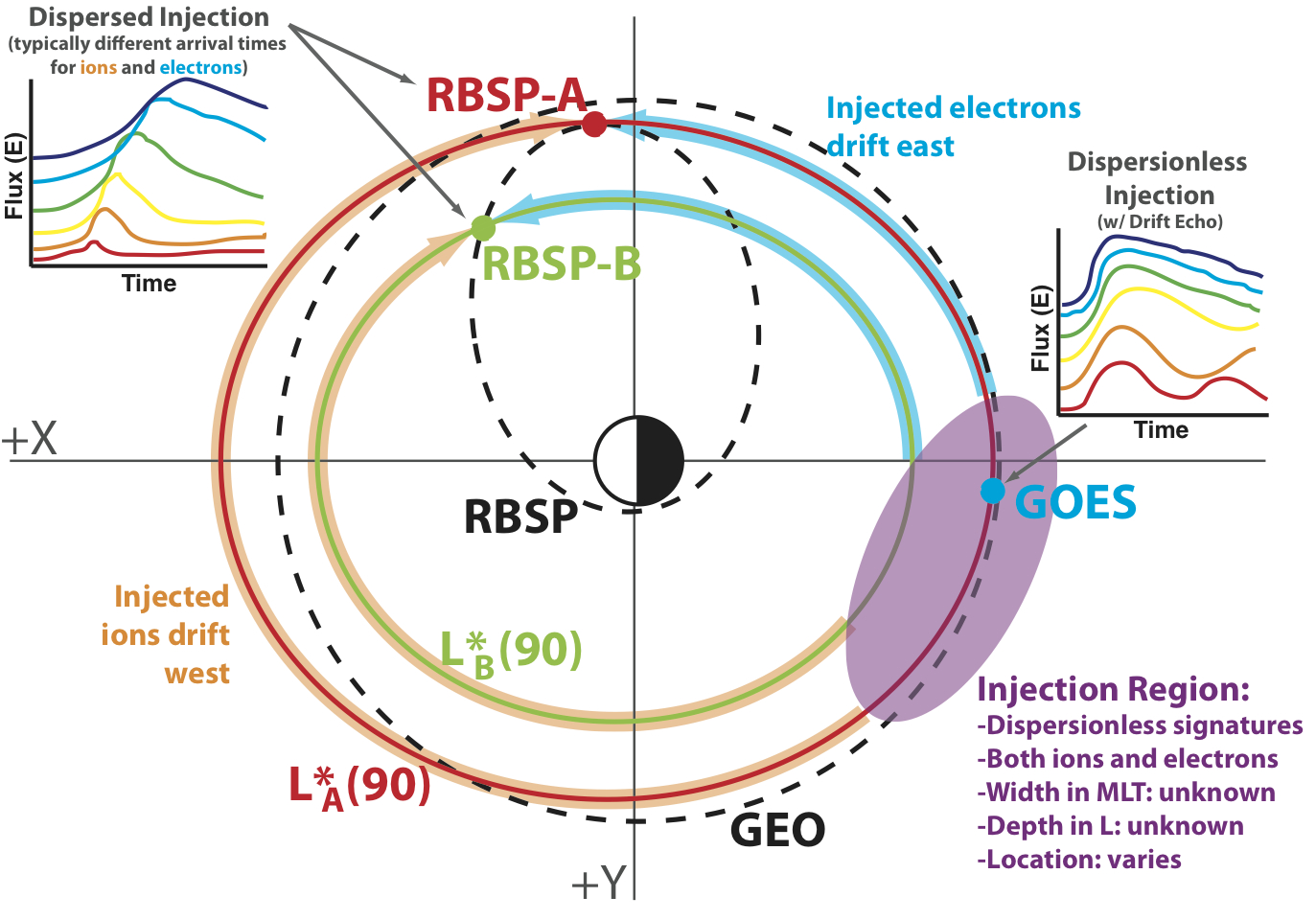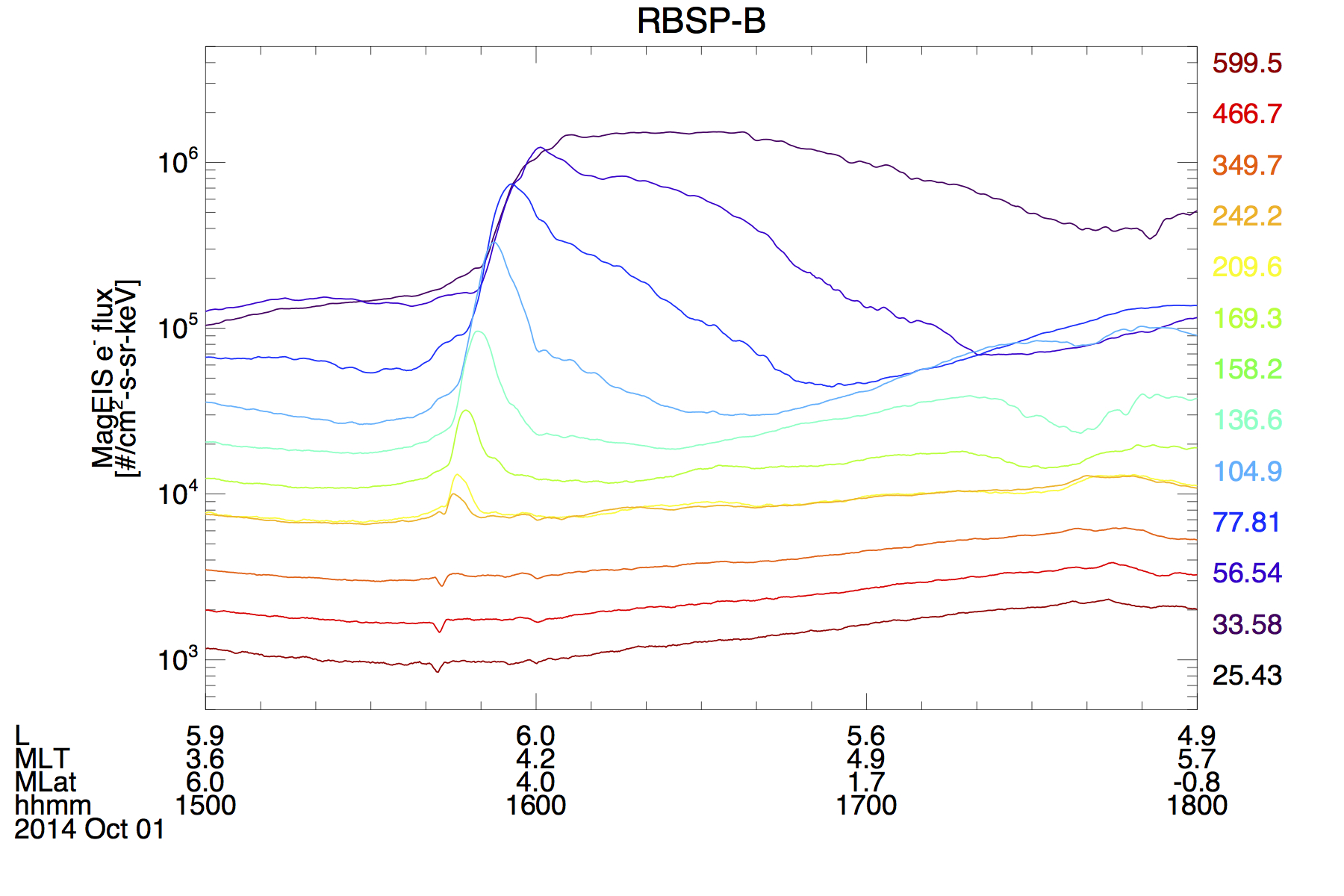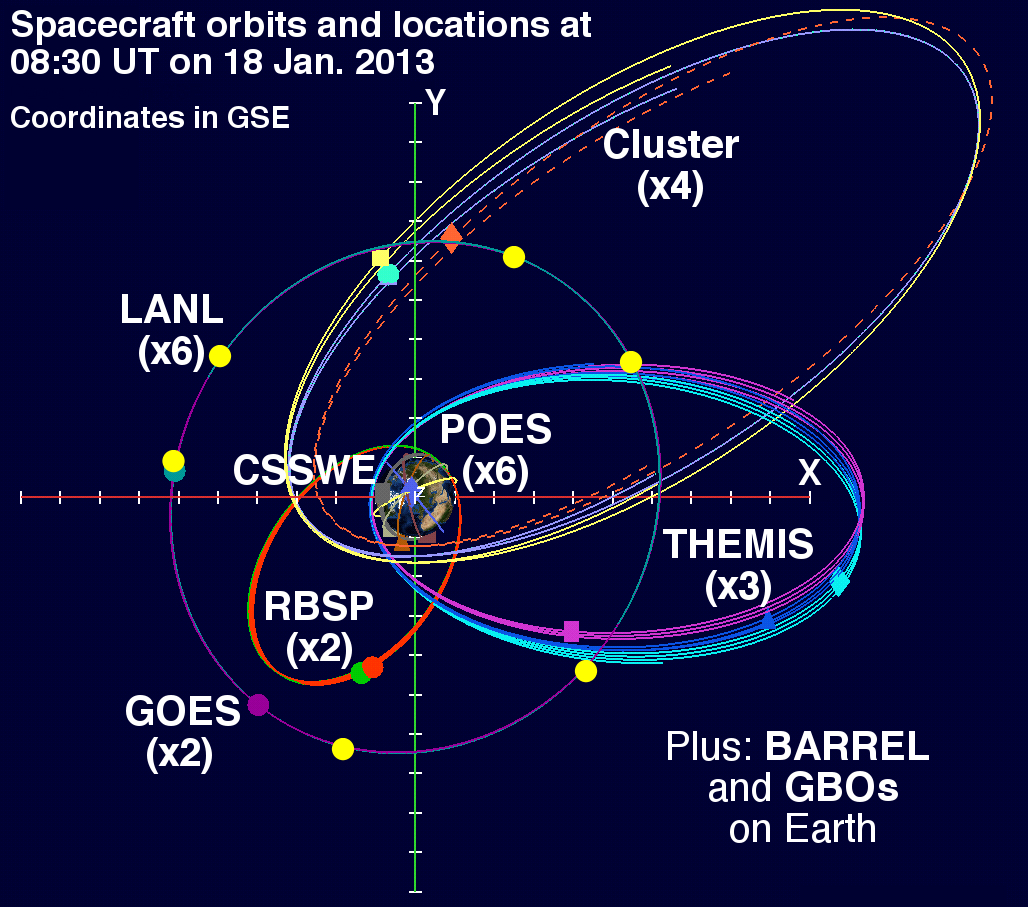About Our ISSI Team Project

Energetic particle injections involve the sudden inward transport of energetic ions and electrons (typically 10s to 100s of keV) from the plasma sheet in Earth’s magnetotail into the inner magnetosphere, where the particles become quasi-stably trapped in the ring current and outer radiation belt. Injections occur regularly (many times per day) and are thought to be important for introducing the “seed population” of electrons into the outer electron radiation belt and the subsequent acceleration of these electrons to relativistic energies (up to several MeV). Particle injections are also considered important for introducing the populations of energetic ions and electrons that contribute to the build-up of the ring current, which can result in geomagnetic storms, and that are responsible for generating various plasma waves, which can then interact with outer radiation belt electrons and contribute to acceleration and loss of those particles. For these reasons, energetic particle injections are particularly interesting from a scientific standpoint, since they represent cross-energy and –species processes in which acceleration and loss of relativistic electrons are affected by the dynamics of lower energy electrons and various ion species.
There is currently only limited and/or indirect observational evidence in support of several of the key concepts and theories to explain energetic particle injections and their effects on Earth's ring current and outer radiation belt electrons. Major outstanding questions remain as to the nature of the injections themselves (e.g., the azimuthal extent and shape of injection fronts), how the upper energy thresholds and penetration depths of such injections vary with solar wind and geomagnetic activity, and the subsequent effect these injections have on the outer belt electron population. However, we now have an unprecedented level of in situ measurements of energetic particles in Earth’s inner magnetosphere that can be used to study energitic particle injections and their effects on Earth's ring current and radiation belts.

Thanks to support from ISSI, we have assembled a team of international scientists and space physics experts to systematically investigate how energetic particle injections affect Earth’s outer radiation belt electrons. Our team is comprised of outstanding researchers hailing from top institutes based in five different European nations, the United States, Canada, Japan, Korea, and China. Each of the members is an expert on the missions, instruments, and analysis techniques used to make and interpret observations of particles and waves in Earth’s radiation belts.

The time period we have chosen to investigate starts at the beginning of NASA's Van Allen Probes (RBSP) science observations in September 2012 and spans up to the present time. From this period, we will use a collection of data sets to establish a database of events and develop case studies and statistics on: the azimuthal location and width of injection sites; the penetration depth (in L-shell) of injections; the upper energy thresholds of injected particles (ions and electrons) as a function of L-shell; differences between ion and electron injections; waves associated with distributions of injected particles; precipitation losses of electrons associated with injections; and evidence of acceleration from outer belt distributions observed by Van Allen Probes. We will incorporate data from: i) NASA's THEMIS and ESA's Cluster missions, which are capable of observing the source of these injections in the near-Earth plasma sheet; ii) geosynchronous spacecraft (i.e., LANL, GOES) that observe the injected particles as they are entering the outer belt zone; and iii) NASA's Van Allen Probes, which directly observe the effects injections have on the outer belt; iv) low-altitude spacecraft and balloon campaigns (e.g., POES/MetOp, CSSWE, BARREL) and ground-based observatories (GBOs) that provide observations required to understand losses from the system.
In 2015, ISSI will host two 1-week meetings for our team in Bern, Switzerland. At these meetings, our team will work together in person to develop and/or establish concepts and theories of energetic particle injections, plan and conduct focused studies of energetic particle injections, and coordinate for continued studies and result dissemination in the interim period. The goal of this team is to conduct a series of observational studies on these main points and share our results with the greater scientific community via a series of peer-reviewed journal publications.
Our ISSI Team

Our team's first group dinner at the Altes Tramdepot. From center-left going clockwise around the table: Mark Clilverd, Christine Gabrielse, Jacob Bortnik, Jean-François Ripoll, Yoshi Miyoshi, Ondřej Santolík, Junga Hwang, Iannis Dandouras, Elena Kronberg, Lauren Blum, Geoff Reeves, Xinlin Li, Sasha Ukhorskiy, Robyn Millan, Emma Spanswick, Drew Turner, and Matina Gkioulidou
| Team Members: | Institutes: | Countries: | Areas of Expertise: |
| Dr. Jacob Bortnik | University of California, Los Angeles | USA | Theory and observations of the plasma waves and wave-particle interactions |
| Dr. Iannis Dandouras | Research Institute of Astrophysics and Planetology (IRAP) | France | Cluster bulk plasma observations and analysis |
| Dr. Junga Hwang | Korea Astronomy and Space Science Institute | South Korea | POES/MetOp energetic particle observations and analysis |
| Dr. Elena Kronberg | Max Planck Institute for Solar System Research | Germany | Cluster energetic particle observations and analysis |
| Prof. Xinlin Li | Laboratory for Atmospheric and Space Physics, University of Colorado | USA | CSSWE, THEMIS, RBSP, and GEO wave, fields, energetic particle observations and analysis |
| Prof. Robyn Millan | Dartmouth College | USA | BARREL baloon observatories and campaigns |
| Prof. Yoshi Miyoshi | Nagoya University | Japan | ERG, POES/MetOp, and GEO wave, fields, and energetic particle observations and analysis |
| Dr. Geoff Reeves (team co-leader) |
Los Alamos National Laboratory | USA | RBSP and LANL-GEO wave, fields, energetic particle observations and analysis |
| Prof. Ondřej Santolík | Institute of Atmospheric Physics | Czech Republic | Cluster and Van Allen Probes waves and fields observations and analysis |
| Dr. Emma Spanswick | University of Calgary | Canada | Ground based observatories (riometers, all-sky imagers, magnetometers) |
| Dr. Drew Turner (team co-leader) |
The Aerospace Corporation | USA | THEMIS, RBSP, POES/MetOp, and GEO energetic particle observations and analysis |
| Dr. Sasha Ukhorskiy | Johns Hopkins Applied Physics Laboratory | USA | Theory of energetic particle dynamics and Van Allen Probes energetic particle observations |
| Young Scientists: | |||
|---|---|---|---|
| Dr. Lauren Blum | Space Sciences Laboratory, University of Califorina, Berkeley | USA | EMIC waves and precipitation of radiation belt electrons and CSSWE observations and analysis |
| Dr. Christine Gabrielse | University of California, Los Angeles | USA | Theory of energetic particle injections and THEMIS observations and analysis |
| Dr. Matina Gkioulidou | Johns Hopkins Applied Physics Laboratory | USA | Theory of ring current dynamics and Van Allen Probes observations and analysis |
| Dr. Eva Macúšová | Institute of Atmospheric Physics | Czech Republic | Theory of plasma waves and Cluster observations and analysis |
| External Advisors: | |||
| Dr. Mark Clilverd | British Antarctic Survey | United Kingdom | Ground based observations and analysis of VLF waves |
| Prof. Wenlong Liu | Beihang University | China | THEMIS, GOES, and Van Allen Probes waves and fields observations and analysis |
| Dr. Jean-François Ripoll | French Alternative Energies and Atomic Energy Commission (CEA) | France | Theory and observations of energetic particles and wave-particle interactions in the inner magnetosphere |
| Dr. Matt Taylor | European Space Agency | Netherlands | Observations and analysis of energetic particles in the inner magnetosphere |
Meetings
- First Meeting: 26–30 January 2015, Bern, Switzerland
- Second Meeting: 21–25 September 2015, Bern, Switzerland

Publications
(team member authors in bold)
- Blum, L. W., A. Halford, R. Millan, J. W. Bonnell, J. Goldstein, M. Usanova, M. Engebretson, M. Ohnsted, G. Reeves, H. Singer, et al. (2015), Observations of coincident EMIC wave activity and duskside energetic electron precipitation on 18–19 January 2013, Geophys. Res. Lett., 42,5727–5735, doi:10.1002/2015GL065245
Website: http://onlinelibrary.wiley.com/wol1/doi/10.1002/2015GL065245/abstract - Clilverd, M. A., C. J. Rodger, M. McCarthy,R. Millan, L. W. Blum, N. Cobbett, J. B.Brundell, D. Danskin, and A. J. Halford(2017), Investigating energetic electronprecipitation through combiningground-based and balloon observa-tions, J. Geophys. Res. Space Physics, 122,534–546, doi:10.1002/2016JA022812
Website: http://onlinelibrary.wiley.com/doi/10.1002/2016JA022812/abstract - Dai, L., C. Wang, S. Duan, Z. He, J. R. Wygant, J. Bonnell, C. A. Cattell, C. Kletzing, D. N. Baker, X. Li, D. Malaspina, J. B. Blake, J. Fennell, S. G. Claudepierre, D. L. Turner, K. Takahashi, H. O. Funsten, G. D. Reeves, H. E. Spence, V. Angelopoulos, K.-H. Glassmeier, X. Tao, L. Chen, S. Thaller, A. Breneman, and X. Tang (2015), The near-Earth injection of MeV electrons associated with intense dipolarization electric fields: Van Allen Probes observations, Geophys.l Res. Lett., 42, doi:10.1002/2015GL064955
Website: http://onlinelibrary.wiley.com/wol1/doi/10.1002/2015GL064955/abstract - Gabrielse, C., A. Runov, V. Angelopoulos, E. Spanswick, and D. L. Turner (2016), Pre-midnight preponderance of dispersionless ion and electron injections, In press for AGU Monograph Series
- Gabrielse, C., C. Harris, V. Angelopoulos,A. Artemyev, and A. Runov (2016), Therole of localized inductive electric fields in electron injections around dipolarizing flux bundles, J. Geophys. Res. SpacePhysics, 121, 9560–9585, doi:10.1002/2016JA023061
Website: http://onlinelibrary.wiley.com/doi/10.1002/2016JA023061/abstract - Gkioulidou, M., S. Ohtani, D. G. Mitchell, A. Ukhorskiy, G. D. Reeves, D. L. Turner, J. W. Gjerloev, M. Nosé, K. Koga, J. V. Rodriguez, and L. J. Lanzerotti (2015), Spatial structure and temporal evolution of energetic particle injections in the inner magnetosphere during the 14 July 2013 substorm event, J. Geophys. Res., 120, doi:10.1002/2014JA020872
Website: http://onlinelibrary.wiley.com/doi/10.1002/2014JA020872/abstract - Gkioulidou, M., A. Ukhorskiy, D. G.Mitchell, and L. J. Lanzerotti (2016), Storm-time dynamics of ring current protons: Implications for the long-term energy budget in the inner magnetosphere, Geophys. Res. Lett., 43, dos:10.1002/2016GL068013
Website: http://onlinelibrary.wiley.com/doi/10.1002/2016GL068013/full - Keika, K., K. Seki, M. Nose, S. Machida, Y. Miyoshi, L. J. Lanzerotti, D. G. Mitchell, M. Gkioulidou, D. L. Turner, H. Spence, and B. A. Larsen (2016), Storm time impulsive enhancements of energetic oxygen due to adiabatic acceleration of preexisting warm oxygen in the inner magnetosphere, J. Geophys. Res. SpacePhysics, 121, doi:10.1002/2016JA022384
Website: http://onlinelibrary.wiley.com/doi/10.1002/2016JA022384/abstract - Kronberg, E. A., E. E. Grigorenko, D. L. Turner, P. W. Daly, Y. Khotyaintsev, and L. Kozak (2017), Comparing and contrasting dispersionless injections at geosynchronous orbit during a substorm event, J. Geophys. Res. Space Physics,122, doi:10.1002/2016JA023551
Website: http://onlinelibrary.wiley.com/doi/10.1002/2016JA023551/abstract - Liu, J., V. Angelopoulos, X.-J. Zhang, D. L. Turner, C. Gabrielse, A. Runov, J. Bonnell, C. A. Kletzing, J. B. Blake, H. O. Funsten, D. N. Baker, and H. E. Spence (2016), Dipolarizing flux bundles in the cis-geosynchronous magnetosphere: Relationship between electric fields and energetic particle injections, J. Geophys. Res., 121, dos:10.1002/2015JA021691
Website: http://onlinelibrary.wiley.com/doi/10.1002/2015JA021691/abstract - Miyoshi, Y., S. Oyama, S. Saito, S. Kurita, R. Kataoka, Y. Ebihara, C. Kletzing, G. D. Reeves, O. Santolik, M. Clilverd, C. J. Rodger, E. Turunen, and F. Tsuchiya (2015), Energetic electron precipitation associated with pulsating aurora: EISCAT and Van Allen Probe observations, J. Geophys. Res., 120, doi:10.1002/2014JA020690
Website: http://onlinelibrary.wiley.com/doi/10.1002/2014JA020690/abstract - Reeves, G. D., et al. (2016), Energy- dependent dynamics of keV to MeV electrons in the inner zone, outer zone, and slot regions, J. Geophys. Res. Space Physics, 121, 397–412, doi:10.1002/ 2015JA021569
Website: http://onlinelibrary.wiley.com/doi/10.1002/2015JA021569/full - Ripoll, J.-F, G. D. Reeves, G. Cunningham, V. Loridan, M. Denton, O. Santolik, W. S. Kurth, C. A. Kletzing, D. L. Turner, M. G. Henderson, and A. Y. Ukhorskiy (2016), Reproducing the observed energy-dependent structure of Earth’s electron radiation belts during storm recovery with an event-specific diffusion model, Geophys. Res. Lett., 43, doi:10.1002/2016GL068869
Website: http://onlinelibrary.wiley.com/doi/10.1002/2016GL068869/abstract - Ripoll, J.-F., O. Santolik, G. D. Reeves, W. S. Kurth, C. A. Kletzing, and D. L. Turner (2016), Highly resolved loss effects of whistler mode waves in March 2013, Submitted to Journal of Geophysical Research
- Temerin, M., and X. Li (2015), The Dst index underestimates the solar cycle variation of geomagnetic activity, J. Geophys. Res. Space Physics, 120, doi:10.1002/2015JA021467
Website: http://onlinelibrary.wiley.com/wol1/doi/10.1002/2015JA021467/full - Turner, D. L., S. G. Claudepierre, J. F. Fennell, T. P. O'Brien, J. B. Blake, C. Lemon, M. Gkioulidou, K. Takahashi, G. D. Reeves, S. Thaller, A. Breneman, J. R. Wygant, W. Li, A. Runov, and V. Angelopoulos (2015), Energetic electron injections deep into the inner magnetosphere associated with substorm activity, Geophys. Res. Lett., 42, doi:10.1002/2015GL063225
Website: http://onlinelibrary.wiley.com/doi/10.1002/2015GL063225/abstract - Turner, D. L., T. P. O’Brien, S. G. Claudepierre, J. F. Fennel, J. B. Blake, E. Kilpua, and H. Hietala (2015), The effects of geomagnetic storms on electrons in Earth’s radiation belts, Geophys. Res. Lett., 42, doi:10.1002/2015GL064747
Website: http://onlinelibrary.wiley.com/wol1/doi/10.1002/2015GL064747/abstract - Turner, D. L., J. F. Fennell, J. B. Blake, B. Mauk, I. Cohen, A. Jaynes, J. Craft, F. Wilder, D. N. Baker, G. D. Reeves, D. Gershman, B. Giles, C. Pollock, D. Schmid, R. Nakamura, R. Strangeway, C. T. Russell, A. Artemyev, A. Runov, V. Angelopoulos, H. Spence, R. Torbert, and J. Burch (2016), Energy limits of electron acceleration in the plasma sheet during substorms: A case study with the Magnetic Multiscale (MMS) mission, Geophys. Res. Lett., 43, dos:10.1002/2016GL069691
Website: http://onlinelibrary.wiley.com/doi/10.1002/2016GL069691/full - Turner, D. L., T. P. O’Brien, J. F. Fennell, S. G. Claudepierre, J. B. Blake, A. N. Jaynes, D. N. Baker, S. Kanekal, M. Gkioulidou, M. G. Henderson, and G. D. Reeves (2016), Investigating the source of relativistic electrons in Earth’s inner radiation belt, Journal of Geophysical Research, 122, doi:10.1002/2016JA023600
Website: http://onlinelibrary.wiley.com/doi/10.1002/2016JA023600/abstract - Turner, D. L., J. F. Fennell, J. B. Blake, S. G. Claudepierre, A. N. Jaynes, T. Leonard, D. N. Baker, I. Cohen, M. Gkioulidou, B. Mauk, J. Burch, V. Angelopoulos, and G. D. Reeves (2017), Multipoint observations of energetic particle injections and substorm activity during a conjunction between Magnetospheric Multiscale (MMS) and Van Allen Probes, in preparation for Journal of Geophysical Research
- Ukhorskiy, A. Y., M. I. Sitnov, V. G. Merkin, M. Gkioulidou, and D. G. Mitchell (2016), Ion acceleration at depolarization fronts in the inner magnetosphere, J. Geophys. Res., 122, dos:10.1002/2016JA023304
Website: http://onlinelibrary.wiley.com/doi/10.1002/2016JA023304/abstract
